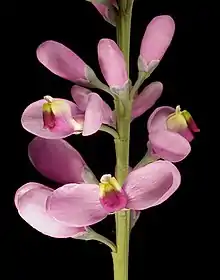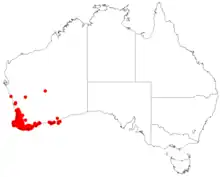| Comesperma virgatum | |
|---|---|
 | |
| Scientific classification | |
| Kingdom: | Plantae |
| Clade: | Tracheophytes |
| Clade: | Angiosperms |
| Clade: | Eudicots |
| Clade: | Rosids |
| Order: | Fabales |
| Family: | Polygalaceae |
| Genus: | Comesperma |
| Species: | C. virgatum |
| Binomial name | |
| Comesperma virgatum | |
 | |
| Occurrence data from AVH | |
| Synonyms[2] | |
|
List
| |
Comesperma virgatum, commonly known as milkwort, is a herb in the family Polygalaceae.[3] It is an erect slender herb growing to between 30 cm and 1.6 m high, on sandy and lateritic soils, and sometimes in swampy conditions. Its pink to purple flowers may be seen from September to December or January to March.[3]
The species was first formally described by French botanist Jacques Labillardière in Novae Hollandiae Plantarum Specimen in 1806, from a specimen collected in Van Leuwin's Land.[1][4]
The species occurs in Western Australia.[2]
References
- 1 2 "Comespermum virgatum". Australian Plant Name Index, IBIS database. Centre for Plant Biodiversity Research, Australian Government.
- 1 2 "Comesperma virgatum Labill. | Plants of the World Online | Kew Science". Plants of the World Online. Retrieved 3 January 2021.
- 1 2 "Comesperma virgatum". FloraBase. Western Australian Government Department of Biodiversity, Conservation and Attractions.
- ↑ Labillardiere, J.J.H. de (1806). "Diadelphia octandria". Novae Hollandiae Plantarum Specimen. 2 (16): 21, t. 159.
External links
This article is issued from Wikipedia. The text is licensed under Creative Commons - Attribution - Sharealike. Additional terms may apply for the media files.